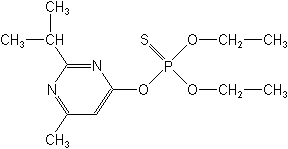-
Common NameDiazinon
-
中文通用名二嗪磷
-
IUPACO,O-diethyl O-2-isopropyl-6-methylpyrimidin-4-yl phosphorothioate
-
CASO,O-diethyl O-[6-methyl-2-(1-methylethyl)-4-pyrimidinyl] phosphorothioate
-
CAS No.333-41-5
-
Molecular FormulaC12H21N2O3PS
-
Molecular Structure
-
Category
-
ActivityInsecticide, acaricide
-
PremixPermethrin+diazinon
Lambda-cyhalothrin+diazinon
Diazinon+Trichlorfon
Diazinon+Fosthiazate
Cypermethrin+diazinon
Acetamiprid+diazinon
Dust, emulsifiable and oil solutions, granule, seed dressing, ULV, wettable powder. Premix Parters: copper oxychloride; copper oxychloride cymoxanil; cymoxanil; permethrin tebuconazole; tebuconazole.
-
Physical PropertiesMolecular weight:304.3. Physical form:Clear colourless liquid(oil) (<ABBR1180> tech.</ABBR>, yellow liquid). d20/4 1.116-1.118, n20/d 1.4978-1.4981. Tech: pale-to-dark brown liquid, at least 90% pure. Density:1.11 (20 °C); Composition:Tech. is 95% pure. Flash point: 62 °C; Vapour pressure:1.2×101 (25 °C) ( OECD 104); Henry constant:6.09×10-2 Pa m3 mol-1 ( calc.); Partition coefficient(n-octanol and water):logP = 3.30 ( OECD 107); pKa:2.6 ( OECD 112); Solubility:In water 60 mg/l (20 °C). Completely miscible with common organic solvents, e.g. ethers, alcohols, benzene, toluene, hexane, cyclohexane, dichloromethane, acetone, petroleum oils.; Stability:Susceptible to oxidation above 100 °C. Stable in neutral media, but slowly hydrolysed in alkaline media, and more rapidly in acidic media; DT50 (20 °C) 11.77 h ( pH 3.1), 185 d ( pH 7.4). Miscible with ethanol, acetone, xylene, soluble in petroleum oils.
-
ToxicologyTech (Rat): Oral LD50 1250 mg/kg. Inhalation LC50 5.4 mg/l (4 h). (Rabbit): Dermal >2020 mg/kg. Mild eye, skin irritation
-
Environmental ProfileEcotoxicology:
Algae:>1ppm.Bees:Highly toxic to bees.Birds:Acute oral LD50 for mallard ducklings 2.7, young pheasants 4.3 mg/kg.Daphnia: LC50 (48 h) 0.96 µg/l.Fish: LC50 (96 h) for bluegill sunfish 16, rainbow trout 2.6-3.2, carp 7.6-23.4 mg/l.Worms:Slightly toxic to earthworms.
Environmental fate:
Animals:The principal metabolites are diethyl thiophosphate and diethyl phosphate.Soil:Degradation involves oxidation to the phosphate (diazoxon) and hydrolysis (J. Pardueet al., J. Agric. Food Chem., 1970, 18, 405-408). DT50 c. 11-21 d (laboratory). Plant:Studies with 14C-labelled diazinon show a rapid absorption and translocation in plants. Metabolism proceeds via hydrolysis and subsequent transformation and degradation of the hydroxypyrimidine derivatives to CO2.
WATER SOLUBILITY: Room temperature 0.004%. -
Transport InformationHazard Class:II (Moderately hazardous)
Porduct NewsMore
US EPA draft biological evaluations of three pesticides’ impacts on endangered species
Chlorpyrifos Diazinon Malathion
Related CompaniesMore
SINO CHEMTECH (SHANGHAI) CO., LTD
Country: China
Tribenuron-methyl Nicosulfuron Dimethomorph Clodinafop-propargyl Diazinon Emamectin benzoate Imidacloprid Thiamethoxam Chlorpyrifos+cypermethrin Bromoxynil octanoate+MCPA-isooctyl BAAPE IR3535
Shenzhen Baocheng Chemical Industry CO.,LTD.
Country: China
Glyphosate Emamectin benzoate Lambda-cyhalothrin Pyraclostrobin Bromacil Glufosinate-ammonium Tembotrione Prothioconazole Topramezone Chlorantraniliprole
Country: China
Glufosinate-ammonium 2,4-D MCPA Dicamba Propanil Clethodim Glyphosate Captan Flumioxazin Sulfentrazone
Country: China
Fipronil Spirodiclofen Florasulam Desmedipham Phenmedipham Ethofumesate Glufosinate-ammonium Diquat dibromide Paraquat dichloride Pyraclostrobin
ANHUI RUIFENG AGROCHEMICAL CO., LTD.
Country: China
Diazinon Emamectin benzoate Lambda-cyhalothrin Methomyl Thiamethoxam Chlorothalonil Paclobutrazol GLYPHOSATE(AMMONIUM) 75%+MCPA(NA)5% SG TERBUCONAZOLE 133G/L+PICHLORAZ 267G/L EW Aluminium phosphide

 0
0 Subscribe
Subscribe
